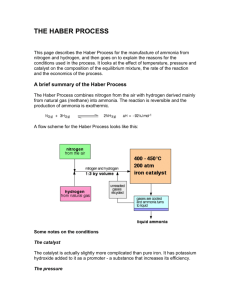THE HABER PROCESS - slider-chemistry-12
advertisement
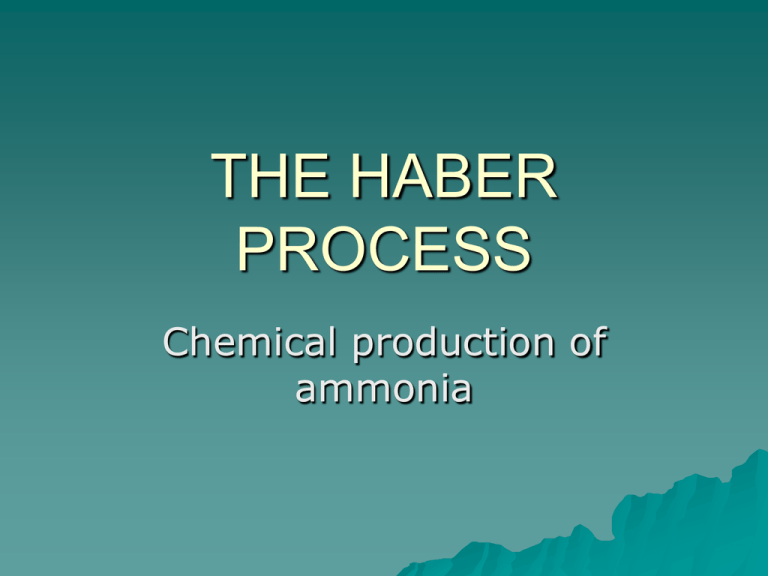
THE HABER PROCESS Chemical production of ammonia The Reaction N2(g) + 3H2(g) 2NH3(g) + 92KJmol-1 The Reactants NITROGEN – From the air by fractional distillation, then cooled & compressed – (air is approx. 80% nitrogen) HYDROGEN – From methane gas reacted with steam CH4(g) + 2H2O(g) CO2(g) + 4H2(g) The Conditions High Pressure 30 MPa Low temperature 450-600 C Catalyst Iron(III) oxide Schematic of Conditions Animation of Haber Process http://www.absorblearning.com/media/item.action? quick=128# Equilibrium Aspects & Explaining the Conditions The Proportions of Nitrogen and Hydrogen Avogadro's Law : equal volumes of gases at the same temperature and pressure contain equal numbers of molecules. That means - gases are going into the reactor in the ratio of 1 molecule of nitrogen to 3 of hydrogen…as per the balanced equation. Why no “excess reagent”? – Excess is important to use up as much as possible of the other reactant - for example, if it was much more expensive- not applicable in this case. – Excess is important to avoid wasting reactor space & space on the surface of the catalyst (since excess reactant would be passing through the reactor yet there isn't anything for them to react with) Le Chatelier's Principle pressure: N2(g) + 3H2(g) Keq = 2NH3(g) + 92 kJmol-1 [NH3]2 [N2][H2]3 increasing the PRESSURE causes the equilibrium position to move to the right increasing the pressure means the system adjusts to reduce the effect of the change, that is, to reduce the pressure by having fewer gas molecules thus, a higher yield of NH3 (more gas molecules on the left hand side of the equation) in terms of the rate of a gas reaction, increasing the pressure brings the molecules closer together, increasing their chances of hitting and sticking to the surface of the catalyst where they can react. Le Chatelier's Principle temperature: decreasing the TEMPERATURE causes the equilibrium position to move to the right reducing the temperature means the system will adjust to minimize the effect of the change, that is, it will produce more heat since energy as a product of the reaction, and will therefore produce more NH3 gas However, the rate of the reaction at lower temperatures is extremely slow… THE TEMPERATURE PUZZLE… Considering rates of reaction, the low temperatures needed to favour the forward reaction make the rate of reaction too slow to be economical Haber sought a “balance” and discovered that an iron(III) oxide CATALYST allowed the rate to increase at lower temperatures Catalyst lowers the activation energy (Ea) so that the N2 bonds and H2 bonds can be more readily broken At these low temperatures, the reduced Ea via the catalyst means more reactant molecules have sufficient energy to overcome the energy barrier to react so, the reaction is faster YIELD – At each pass through the reactor, only about 15% of the reactants are converted into products under these conditions, but this is done in a short time period. – Ammonia is cooled and liquefied at the reaction pressure, & then removed as liquid ammonia. (how does this affect the equilibrium?) – The remaining mix of nitrogen and hydrogen gases (85%) are recycled & fed in at the reactant stage. – The process operates continuously & the overall conversion is eventually about 98%. Uses of Ammonia Nitric acid Ammonium nitrate (& other salts) ~ fertilizer & explosives Fibers and plastics Pharmaceuticals (nylon) (B vitamins nicotinamide & thiamine) Cleaning products Mining & metallurgy Pulp & paper The Paradox of Science ~ potential for good & for evil Fritz Haber, German chemist, 1868-1934 Winner of the Nobel Prize of Chemistry (1918) for the synthesis of ammonia from its elements Carl Bosch developed the industrial process for the Haber process. The perfection of the Haber-Bosch process encouraged Germany to continue fighting World War I because they could convert ammonia to fertilisers and explosives. Father of chemical warfare? – Haber perhaps served his country in the greatest capacity. Without his process, and its applications, Germany would never have had a chance to win the war. – During the war, Haber was first to use chemical warfare with chlorine gas in Ypres. France (1915). Up to 15,000 died. – Hitler's regime ordered his exile due to his Jewish origins. references Nelson Chemistry12 http://www.ausetute.com.au/haberpro.html http://www.chemguide.co.uk/physical/equilibria/haber.html http://www.gcsescience.com/h.htm www.marymount.k12.ny.us/marynet/06stwbwrk/06hchem/kcflash/kcreaction.html
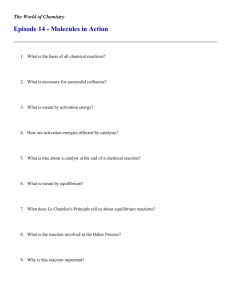
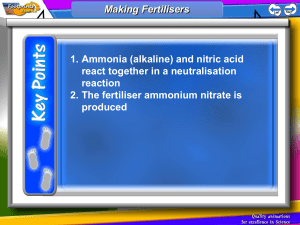
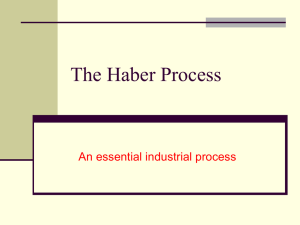
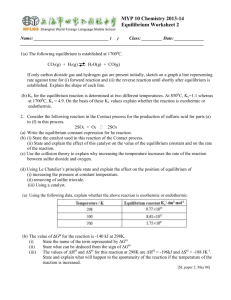
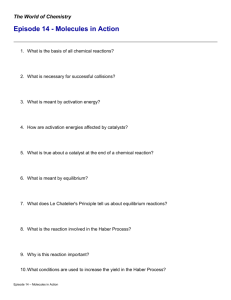
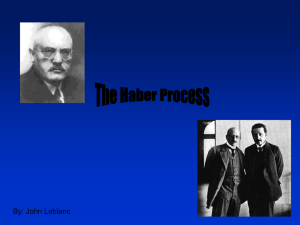
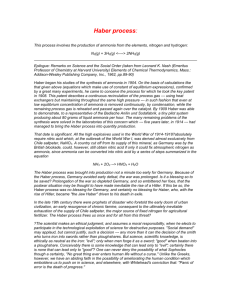
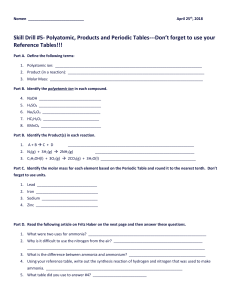
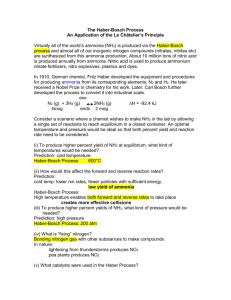
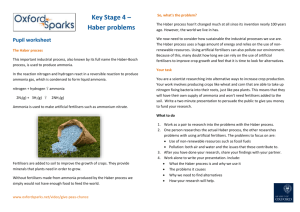
![mic_class10_10.ppt [Compatibility Mode]](http://s3.studylib.net/store/data/008220705_1-eb9498ce6cd0ab3209762ef99981a3a3-300x300.png)
